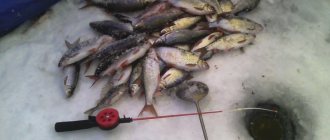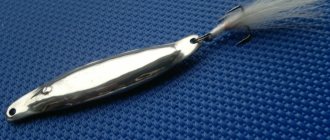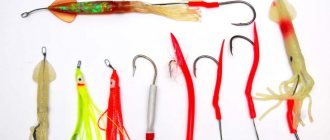Fans of fish products, sparing no effort, argue about whether roach and ram have differences in taste, method of preparation, appearance and other features. Only true experts can immediately tell what the difference is between the varieties of fish product - ram and roach.
In fact, both of these fish are nothing more than roaches. Roaches usually live in freshwater bodies of water. If she has enough food, and she eats plants, insect larvae and mollusks, then her habitat will remain unchanged.
With a meager diet, the fish begins to migrate in search of profit and often gets out of a freshwater reservoir into sea waters (the pre-estuary part of the river).
Ram and roach: the difference in fishing
Roach that spawns in fresh waters and feeds in desalinated waters is called semi-anadromous roach. This fish caught in the Caspian Sea basin will be called roach. Fishing for semi-anadromous roach in the Black and Azov Seas is already a ramming operation.
Such species of fish grow and develop faster than ordinary freshwater (live) roach, which does not go beyond the traditional spawning site. It is worth saying that roach, ram and roach gather in schools of fish before spawning, which makes fishing easier.
How to distinguish roach from roach?
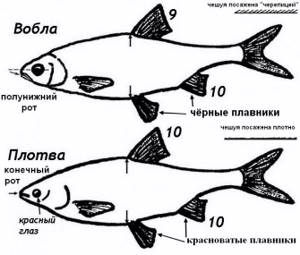
To quickly, so to speak, expressly determine whether it is a roach or a roach, you can use the following series of signs:
- Mouth position.
The roach has a semi-inferior mouth, the apex of the mouth is below the level of the lower edge of the eye.
The roach has a terminal mouth, the apex of the mouth is higher than the level of the lower edge of the eye.
2. Planting scales (my personal, so to speak, life hack)
The roach’s scales sit in a “tile” pattern; if you run the tip of a knife across it without pressing from the tail to the head, you will hear a clear “trrrrr” sound (the same as if you, touching the computer keyboard with just your fingertips, quickly ran your hand across it)
The roach's scales sit tightly, like those of silver crucian carp (incorrectly called "buffalo" by the people), if you run the tip of a knife along it without pressing from the tail to the head, there will be no cracking sound.
This sign can be used even in semi-darkness!
3. Lifetime coloration of eyes and fins
The roach has an iris and all its fins are black.
The roach has a red iris and reddish fins.
This sign has the disadvantage that the pigmentation of the caught fish disappears quite quickly.
4. Rays
The roach has 9 branched rays in the dorsal fin and 10 in the anal fin.
The roach has 10 branched rays in the dorsal fin and 10 in the anal fin.
Counting rays requires care.
Cooking salted fish
Roach and ram differ not only in habitat, but also in size, that is, in morphological characteristics. Roach, for example, is larger than ram and even more so roach. Despite the external differences, these types of fish are prepared according to the same recipes.
Traditionally, this fish is salted, dried and dried, while ram gave the name to the entire assortment of small-sized salted dried fish - ram. Consequently, this pseudo name can hide a ram, a roach, and the same roach.
It is better to salt this fish in a dry way, that is, rub it with salt.
Small fish are only cleaned of scales (and even then not always), half-kilogram carcasses are better cleaned of entrails. Place the grated fish carcasses in rows in a wooden container and sprinkle thoroughly with table salt.
The fish will be salted in a refrigerated room for at least two weeks. Larger carcasses may require more for salting. At room temperature, pickling time is a week.
Roach fishing
In April, fishermen begin to come to the banks of the Volga, and the fishing season begins. Hungry fish, after breeding, readily rush to bait. This period has restrictions on the number of fish caught, so it’s worth finding out in advance to avoid problems with the law.
Story
There were times when preference was given to expensive, red varieties of fish. Then it was noticed that the migration of roach occurs earlier than herring, they began to catch it, but on a small scale. The nutritional value and taste of roach were not immediately appreciated: earlier, when fishing, if it got caught in a net, fishermen often simply threw it away. In the difficult nineties, small and large businessmen decided to sell this fish and were right.
To learn more:
What bait is best to use for silver carp?
Fishing places
It is difficult to find a specific place on the river bank where a lot of fish are caught, since the roach is constantly on the move. Fishermen choose the area they like and wait for the flock, casting a donk or fishing rod. When the school approaches, the fisherman's hand gets tired of getting the fish, but soon there is a lull, the school swims away, and he again has to wait for the next school. The bait is cast further from the shore, since large fish live in the depths.
Fishing methods
They catch roach using bottom, float rods or a feeder. On the gear used, different attachments are used in the form of: hooks, hooks, weights, feeders. You can attach up to four hooks to a float rod. Since roach fishing takes place in the river flow, a weight or feeder for the feeder must be selected weighing at least 40 grams so that the river current does not carry it away. When the roach bites well, it is troublesome to get the heavy gear you use every time; a light rod is required. Fishing with a feeder with a thick line has become popular. A thick line (0.25 in diameter) does not frighten a hungry fish at all; on the contrary, it greedily pounces on the bait.
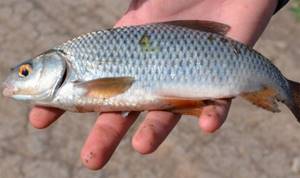
Lure
Various porridges with the addition of mixed feed serve as bait for roach. For better fishing, crushed earthworms or maggots should be added to the groundbait or groundbait. You can make bait yourself by finding recipes on the Internet, or purchase ready-made bait at a fishing store.
Dried fish
Before salting the fish, it is allowed to dry for several hours. Then they are treated with salt, as with dry salting, strung on a fishing line through the eye sockets (small fish can be collected in bunches of several pieces) and soaked in a saline solution for two days.
By the way, if you dry fish in the summer, then the salting time in the solution is no more than a day.
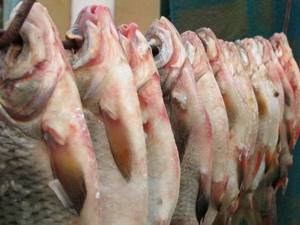
Subsequently, the ligaments are removed and washed with water. Hang the fish in an open, well-ventilated place; you can cover it with gauze to protect it from insects and dirt.
Dried ram will be ready in 2 weeks. Please note that in summer you need to monitor the fish more closely, as a product exposed to the sun may become bitter.
How to choose?
When choosing a roach, pay attention to the eyes; they should not be cloudy. The scales should fit snugly to the body. There should be no mucus on the clean surface. The body should be elastic and when pressed, the shape should be restored.
You need to choose roach in a store or market correctly so as not to buy a low-quality product and not cause harm to your health. We recommend that you take note of a few tips on choosing fresh and dried fish.
- When choosing dried roach, pay attention to its scales. It should be shiny and dry. The scales should also be free of white plaque, spots and damage. The smell should not contain any foreign impurities. Also make sure that the roach is completely covered with scales. If there are not enough scales in some places, it means the fish is not the freshest. In addition, when purchasing, inspect the product, paying special attention to the abdomen and gills. Under no circumstances should there be moisture in these places, and if there is moisture, this means that the fish is stale and was previously soaked in a solution to remove unpleasant odors.
- Dried roach should also have no damage to the body, all scales should be intact, and there should be no spots on the fish. Foreign odors are unacceptable. A good product stands out from others by the rib bones protruding from the belly, as well as intact fins. If you want to select a fish with caviar, feel the belly. It should be elastic and convex. The meat of dried roach should not be as hard as dried roach, especially on the back. Particular attention should be paid to cutting fish, since at this stage worms can be detected in the meat. In this case, it is better to throw away the spoiled product.
- Fresh roach should also be selected carefully. First you need to lift the gills and smell the fish. There should be no other smell other than sea and mud. Fresh roach does not even have a characteristic fishy smell, so take this fact into account when choosing a product. The scales of a fresh roach should be smooth and moist unless the fish is frozen. Cracks and defects on the carcass indicate that the product was stored incorrectly and it may be spoiled. The gills are bright red or pink, and the eyes are bulging and transparent.
Do not hesitate to ask the seller for a quality certificate, which will confirm that the products have indeed passed the necessary tests and are suitable for consumption. Also, when choosing a roach, follow our recommendations to buy a quality product.
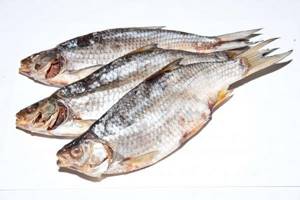
to “Ram and roach - the difference between these fish, what are the differences from a culinary point of view”
- Romarik
:01/29/2016 at 3:01 am
In fact, since the opening of this topic, I’ve been waiting for people to talk about the roach enough to ask who the rudd is. According to my amateurish considerations, this is what different fish are called in different places.
Answer
Fish Chef
:
01/31/2016 at 3:50 pm
No, this is a separate fish. It is the same in both Astrakhan and the Urals. And it's called the same.
Answer
:
03/23/2016 at 12:41 pm
I don’t care if it’s a ram or a roach... I want it, it’s still delicious...
Answer
:
05/12/2017 at 11:02 pm
We have the most delicious ram in the Kuban! The secret is in the salting and drying itself! No cleaning or gutting! We salt it in a stainless steel tank, laying it in layers and sprinkling it with plenty of salt, it is salted for 3-5 days, depending on the size of the fish. Then it is washed from the salt, filled with cold water and soaked for a day. Stringed on a thick thread and dried in a draft under a canopy! After a week you will simply lick your fingers!!!! The main thing is to protect it from flies!
Answer
:
06/24/2018 at 5:27 pm
The most delicious roach on Manych
Answer
- Sergey
:
03.11.2018 at 10:20 am
The most delicious roach with beer.
Answer
Lifestyle
Vobla belongs to the semi-anadromous form of roach and is one of its subspecies, which spends most of its life in the coastal regions of the Caspian Sea. All summer long, the roach feeds in shallow sea waters rich in food, and with the onset of autumn frosts it approaches the mouth areas of rivers and disperses in the area of the deepest holes. When the water temperature drops to 7 degrees, sea roach loses its activity and falls into a state similar to suspended animation. During hibernation, her body is covered with a thick layer of mucus, which provides protection from blood-sucking sea bugs and maintains a stable body temperature.
As spring approaches, sea roach begins to return to activity and rises upstream in the rivers flowing into the Caspian Sea. The first individuals begin to appear in rivers long before the ice melts. By the end of February - beginning of March, half the roach population is in the rivers. The most massive entry of fish into rivers occurs when the water warms up to 10 degrees. This period usually occurs at the end of March - beginning of April, one to two weeks after the ice melts. Trying to quickly get to the spawning grounds, the roach enters all the numerous Volga channels. The upper limit of roach migration up the river is in the Volgograd region.
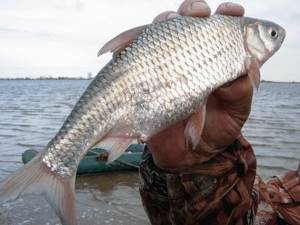
The presence of a V-shaped notch on the anal fin is one of the main differences between roach and roach.
Roach fishing in April
During spawning itself, sea roach completely stops feeding. Her vitality is maintained by the fat reserves she acquired while climbing up the river.
The desire of the fish to stock up on a large amount of fat before spawning makes it grab any living creature while moving to the spawning grounds. This is precisely what explains the active bite of roach on fishing gear in the spring. The earlier an individual entered the river, the greater its chances of successful spawning. A significant part of the population does not rise up the Volga, but remains in its estuary areas, where they lay eggs. However, on the Volga rivers there are quite a few areas suitable for spawning, so roach is stuffed in large quantities into places suitable for spawning:
- shallow waters overgrown with reeds;
- shallow channels;
- backwaters;
- eriki.
The next fish to spawn rises along the Volga channels at a fairly high speed, while sticking to the central part of the river. If the current is too strong in some area, then schools of sea roach are pressed to the shore, where the pressure of the water flow is less noticeable.
For spawning, the fish chooses well-warmed shallow areas with standing water, where the depth does not exceed a meter mark. A significant part of the roach is doomed to death after spawning, since the water level drops rapidly after a flood and all shallow areas remain cut off from the main river bed and gradually dry up. Around such natural dining areas, many fish-eating birds and animals always gather, wanting to profit from trapped fish. A significant part of the sea roach population dies at sea when strong waves wash ashore weakened individuals returning from spawning.
Like most carp fish, the roach acquires a nuptial plumage before spawning. Small white growths appear on her head, and her scales become rough to the touch. The entire body is covered with thick whitish mucus. After spawning, sea roach loses a lot of strength. Her body uses up all its reserves of subcutaneous fat, and the fish becomes very thin. The roach's body becomes narrow and acquires a darker color. Exhausted from spawning, she returns to the sea. During the return journey, the fish no longer form large schools and go to their permanent habitats separately.
Spawned individuals are not of interest to fishermen, since their meat has low taste.
Where and how to properly store it at home to prevent it from drying out?
At first glance, it may seem that you can store roach at home for a very long time, but if stored incorrectly, it can dry out. To prevent this from happening, you must adhere to simple rules, which we will discuss in our article.
- If you need to store dried or raw roach for a long time, it is best to do this in the freezer. To do this, the fish should be wrapped in cling film or a plastic bag and placed in the freezer. After defrosting, the dried roach will need to be dried a little. You can also store the product on the bottom shelf of the refrigerator, but this option is not suitable for raw fish and is less durable.
- Another option for storing dried roach is glass or plastic containers. A little medical alcohol is poured into the bottom of the container, after which dried fish is placed in the container. You can also do without alcohol if you take a glass container and throw a lit match into it so that all the oxygen burns out. Then you should fill the container with fish and roll up the lid, storing it in a dark, dry place.
- If you want to store the fish for no longer than a month without allowing it to dry out, you can leave it hanging in the same room where it was dried. In thirty days the roach will not dry out much more. If you are still worried, you can spray the product with drinking water from a spray bottle once a week.
- You can also use large wooden boxes to store fish. Making them yourself is not difficult. To do this, you need to take thin leaves of plywood and make a box out of them, inside which you will equip fastenings for hanging fish. Holes for ventilation should be made in the walls of the box, and the outside of the box should be covered with gauze to protect the fish from insects. In this way, you can store dried roach from a month to three.
By following our recommendations, you will be able to properly salt roach, and also learn how to store and catch it. At the same time, do not forget that it is advisable to cook fish that was recently caught, since in this case the product will be more aromatic and will have a rich taste.




